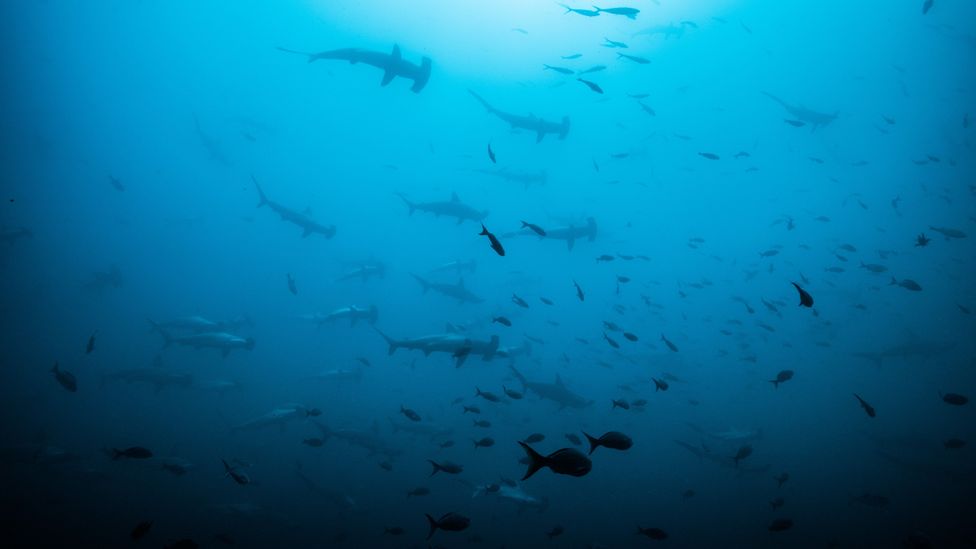As Stephen Palumbi looked around the deep blue water, he had the eerie impression that something wasn't right. It was the summer of 2016 and Palumbi – a professor of marine sciences at Stanford University – was on an expedition, scuba diving to assess the state of an obscure patch of reef in the Central Pacific.
What he and his fellow researchers found was a forgotten world of astonishing abundance – grazing herds of plump parrotfish, eight-metre- high (26ft) forests of branching corals, humphead wrasse the size of baby rhinos… and sharks. So many sharks. "You couldn't look in any direction without seeing one or two," he says.
But there was also an atmosphere of the abnormal – a scattering of uncanny clues that this place was different. "Every time you turned around, there was something strange going on," says Palumbi. Like a mysterious crack in the reef. Small, irregular fissures are not uncommon, except this one was in a perfectly straight line – an orderly chasm at least a mile long.
And then there was the navigation incident. Earlier, his team had been aboard the dive boat, about to drop anchor in a lagoon several kilometres from the nearest land, when the navigation system started "screaming" – according to its calculations, they had run aground. They hadn't.
Palumbi was diving in one of the most radioactive places on Earth: the Bikini Atoll, in the Marshall Archipelago. Nearly seven decades earlier, this ring-shaped band of islands – formerly an archetypal tropical paradise – had been used to test the atomic bomb. Over 12 years in the 1940s and 50s, the US blasted its tranquil waters and those of a neighbouring atoll with 67 nuclear weapons equivalent to 210 megatonnes of TNT – more than 7,000 times the force used at Hiroshima. Palumbi's navigation system was off because certain islands, still recorded on older maps, had been entirely vaporised by the explosions.
This dark past has left a devastating legacy for the Bikini islanders, who have been unable to return to their home ever since. But it has also created an accidental sanctuary: a place where wildlife is protected by the area's very toxicity. For almost 70 years, there has been no fishing.
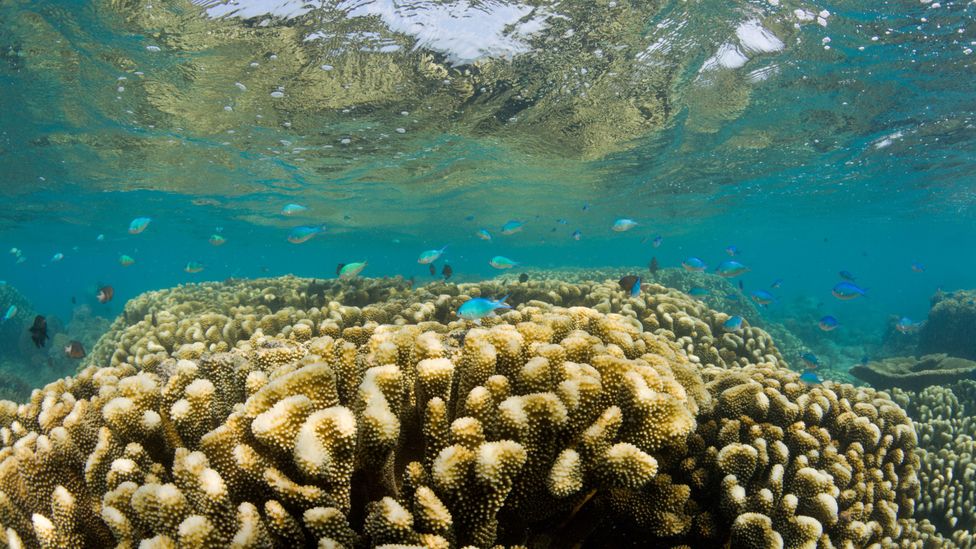
Today life in Bikini lagoon is thriving, possibly as a result of decades without fishing (Credit: Alamy)
On land, most of humanity hasn't relied on hunting and gathering for millennia. For the average American, shooting an armadillo for dinner would be considered somewhat unorthodox.
But this is not the case for the oceans. As our population has increased, so has the amount of wild seafood we eat, and today, it makes up a significant portion of the diets of three billion people worldwide.
However, this free buffet has had radical consequences. In less than a century, once-thriving ecosystems have become deserts, one of the world's favourite fish is nearing extinction and at the collapsed fishery in Newfoundland, up to 810,000 tonnes of cod that were historically caught each year have gone missing. In fact, humans have utterly transformed the planet's oceans, decreasing the total biomass of fish by an estimated 100 million tonnes since prehistoric times. It's thought that 90% of the planet's fish stocks have already been used up.
There is a growing movement to change this. This year, the United Nations (UN) signed a historic agreement: the "high seas" treaty, which aims to protect marine life in areas of the open ocean that are not controlled by any country. This vast swathe of the Earth's surface, which accounts for more than two-thirds of the world's oceans, will no longer be a commons where anything goes – at least, that is the plan.
Of course, humanity isn't aiming to stop fishing entirely. But what would the seas look like if we did decide to permanently abscond from it? Asking this simple question can provide a surprising insight into the profound impact we are currently having on the planet's largest ecosystem – and reveal what we can do to help it recover.
A new abundance
For decades after the Bikini Atoll experiments, the islands were a place of ghosts – other than caretakers, no humans have lived there since the 1950s.
So, when Palumbi rolled off the boat into the atoll's central lagoon in 2016, together with his colleague Elora López-Nandam – now a postdoctoral researcher at California Academy of Sciences – they had no idea what they would find. After all, even the coconuts strewn across local beaches are radioactive.
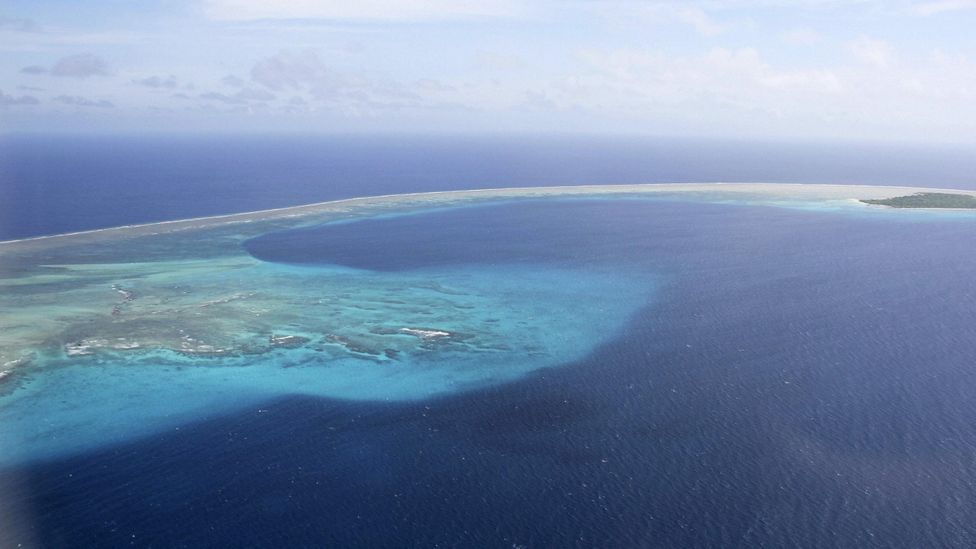
The nuclear weapons detonated at Bikini Atoll vaporised three islands (Credit: Alamy)
The pair were diving in Bravo Crater, a basin 75m (246ft) deep and 1.5km (0.9 miles) wide in the north of the island chain. The water column there is relatively low in radiation, with amounts comparable to background levels in most of the world. But the sediment on the bottom tells another story – to this day, it has high concentrations of radioactive plutonium, americium and bismuth, higher than anywhere else in the Marshall Islands. This is where, on the morning of 1 March 1954, the US conducted its largest ever thermonuclear test.
Over six decades later, Palumbi and his colleague were awed by what they saw. The centre of the crater is still relatively barren, with just a thick layer of silt. But at the edges, they found a hidden refuge, where rainbow shoals of small fish circled boulder corals the size of small cars, and the distinctive torpedo-like forms of blacktip and grey reef sharks were omnipresent.
"It's mind-blowing," says Palumbi. Despite battling the effects of radiation, which is thought to have created a population of mutant sharks missing their second dorsal fins, the reef was very much alive. And the fish were giants – at least, compared to those you would find in places that are regularly plundered for their fish.
This is the most obvious consequence of abandoning fishing – there would be more fish, and they would be much bigger than modern generations are used to.
A rapid response
Back in March 2006, George W Bush – the then-US president – was watching television at the White House. According to popular rumour, on the programme that day was a PBS documentary about the Northwest Hawaiian Islands, a remote archipelago in the Pacific. He was apparently so enchanted, that he immediately began looking into ways to protect them. With the help of an obscure, century-old law, he created the Papahānaumokuākea Marine National Monument – now the largest marine conservation area in the world.
Unlike vast expanses of other marine protected areas, which still allow fishing – no-take zones represent just a fifth of this category – the new reserve imposed a total ban.
The impact was almost immediate. "We started to see effects after about one and a half years," says John Lynham, a professor of economics at the University of Hawaiʻi who specialises in ocean recovery. There was more marine life around overall, with the speediest recoveries from species that were previously harvested the most heavily, he says. Amazingly, yellowfin and bigeye tuna were among the first to respond – although they're apex predators and adults average at least 6ft (1.8m) in length, they're fast-growing.
Like at Bikini Atoll, other notable reprises have been total accidents. Take the advent of World War Two in September 1939. For the next six years, the North Sea was almost entirely devoid of fishing. With large, sturdy designs and clear, open decks, fishing trawlers were relatively easy to convert into minesweepers – warships that scoured the oceans for mines and discharged them. Along with the dangers posed by mines, warships and bombing to civilian fleets, this meant there were very few active fishing vessels for the entire duration of the war.
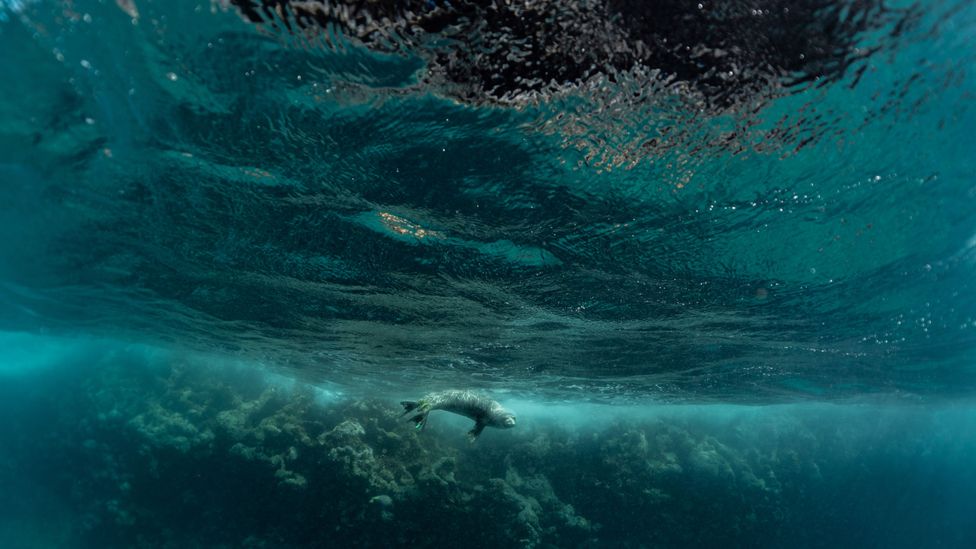
Papahānaumokuākea Marine National Monument is home to one of the rarest marine mammals on Earth, the Hawaiian monk seal (Credit: Getty Images)
Fish in the North Sea took full advantage, and their numbers exploded. The oldest individuals benefitted first. Where many would usually have been caught, they got to hang around – and eventually reproduce. This led to more babies, and in turn, a larger population in the next generation. And so on, and on, in a process that's been compared to a Mexican wave. (Tragically, when regular operations resumed, it's thought that the post-war abundance of fish may have contributed to a fishing boom that led to an unprecedented exploitation of their world.)
Of course, no matter how seriously humanity takes its imaginary fishing ban, some damage will never be reversed. The tragedy of overfishing means that many marine species have already vanished from the oceans forever. Even for those that remain, there are many other barriers in the way of a full recovery, from habitat loss to local extinctions.
However, perhaps the most striking effect of a global moratorium on fishing would be the sharks.
A predator boom
In a corner of the Museum of Zoology in Lausanne, propped up on a pedestal, is a slightly odd-looking great white shark. With an unusually upturned snout and jaws curled into a shy smile, it contains all that remains of an individual caught in 1956. Most of the fish's body is a model, a somewhat artistic interpretation of the real-life animal, with just her fins and teeth.
Measuring 5.9m (19.4ft) long, she was almost the size of a speed boat. But what's particularly remarkable about this giant is where she was found: not in South Africa, Australia, Florida, or any of the usual shark-infested waters. Instead, she was apprehended near Sète, off the coast of southeast France. This was one of Europe's last great white sharks.
In fact, it's thought that the Mediterranean was once swarming with sharks. Hammerhead, blue, mackerel and thresher sharks lived alongside an ancient population of great whites that inhabited the area for 450,000 years. In 2010, research led by Chrysoula Gubili – a researcher at the Fisheries Research Institute, Greece – concluded that they may have originally got there when a lone female took a wrong turn.
Today there are still some large sharks lurking in the Mediterranean, including the occasional native great white – they're endangered, with too few sightings to estimate how many. But for those shark species for whom data is available, numbers in Europe's favourite swimming spot have declined by between 96 and 99.99% since records began in the early 19th Century.
You might also like:
- What would a green world cup look like?
- What if polluters paid for climate change loss and damage?
- What would happen if we had limitless green energy?
The main beneficiaries of these absent sharks have been prey animals, particularly smaller fish. One analysis, using data stretching back to 1880, estimated that the total biomass of predatory fish in the world's oceans has declined by two-thirds over the last century alone – while at the same time, the biomass of smaller species has increased.
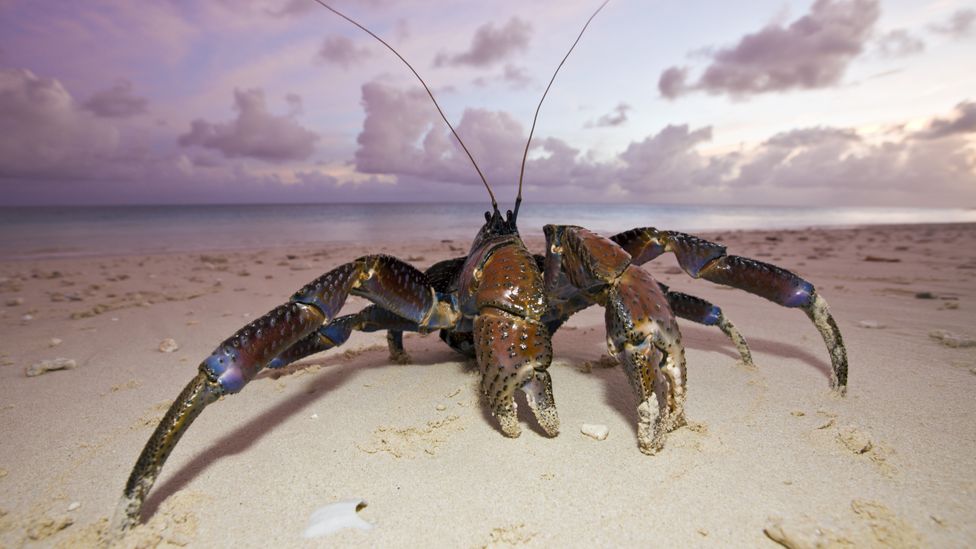
Today there is an abundance of hubcap-sized coconut crabs on Bikini Island – though the animals are radioactive (Credit: Getty Images)
In a world without fishing, Lynham believes that these lost pescatarians would soon return – at least, those that aren't already extinct. Then we'd start to see a rebalancing of the ocean ecosystem. "There's probably over time, going to be more top predators, and that may actually lead to lower abundances of species that they feed on," he says. Fish that have been exploiting the absence of Mediterranean sharks might suddenly find that they are dinner.
And though most sharks are peaceful sea-puppies, with little interest in consuming humans, it's also possible that turning away from fishing could lead to a small increase in already-low numbers of shark attacks on humans. For example, some experts believe that the success of a shark conservation programme around Long Island might have contributed to an increase in the number of bites in recent years, none of which have been fatal.
However, there would also be some more surprising consequences for the world's oceans. One is a reduction in plastic.
A hidden benefit
Though plastic bags, cotton buds, straws, cigarettes and food packaging are starving, drowning, entangling and poisoning millions of marine animals every year – and contributing to the microplastics contaminating the food chain – the vast majority of large plastic in the oceans isn't ordinary rubbish. It comes from fishing.
Take the North Pacific subtropical gyre – an immense system of circulating ocean currents that is home to some of the oceans' most enchanting wildlife, with whales, sharks, sea turtles and fish. This open ocean ecosystem is over 1,000 miles (1,600km) from land. And yet, it is most famous as a trash vortex – a system that has trapped mind-boggling quantities of human rubbish, giving it another name, the North Pacific Garbage Patch.
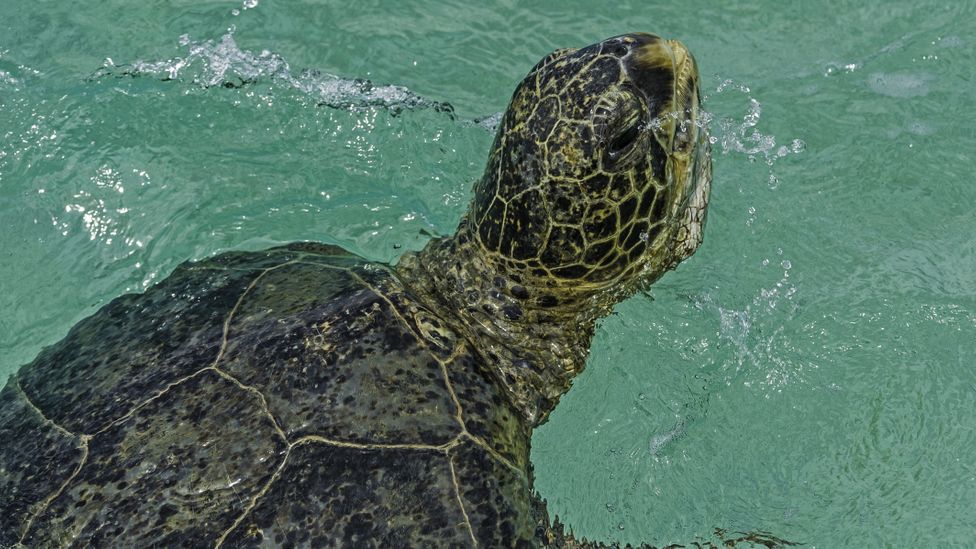
In the absence of fishing, many other marine animals benefit too – with more food to eat, healthier habitats and a lower risk of becoming bycatch (Credit: Getty Images)
According to a study published last year, more than three quarters of the larger debris trapped in this floating rubbish pile comes from so-called "ghost" fishing gear – nets, ropes and lines that continue to prove deadly to ocean wildlife, long after they are discarded from the side of a fishing boat.
Carbon Count
The emissions from travel it took to report this story were 0kg CO2. The digital emissions from this story are an estimated 1.2g to 3.6g CO2 per page view. Find out more about how we calculated this figure here.
Of course, in a post-fishing world, the existing rubbish in our seas would not just disappear. For the plastic that makes it to the deepest parts of the ocean, the process of breakdown could be especially slow. According to one estimate, polyethylene may take up to 292 years to be fully degraded on the deep sea floor, while other plastic will likely last for far longer.
Over time, the amount of plastic in our seas would decrease – so long as humans didn’t compensate for it by throwing more plastic into the ocean from elsewhere. But even if we stopped polluting the oceans with this equipment tomorrow, the last fishing line wouldn’t fully degrade until the year 2623, according to the findings of another study. In the meantime, plastic pollution could continue its killing spree – currently it is thought to lead to the deaths of around a million marine animals every year.
Finally, there's climate change.
The deep oceans are a graveyard – when larger creatures such as big fish, sharks or whales die, they sink to the bottom, where they often become entombed in anoxic sediment – a natural preservative that prevents them from decomposing fully and traps the carbon in their bodies for millennia.
But over the last century, humanity has emptied the world's oceans of their giants. As a result, this carbon sink has not been operating at its usual capacity – and unprecedented numbers of the fish that remain in the ocean will eventually release their carbon back into the atmosphere. According to one analysis, this means fishing has released at least 0.73 billion tonnes of carbon dioxide since 1950, roughly similar to the entire emissions of Germany in 2021.
That's not to mention the destructive power of specific fishing techniques, like trawling, which disturbs carbon-trapping sediment on the seafloor, leading to annual emissions equivalent to the entire aviation industry.
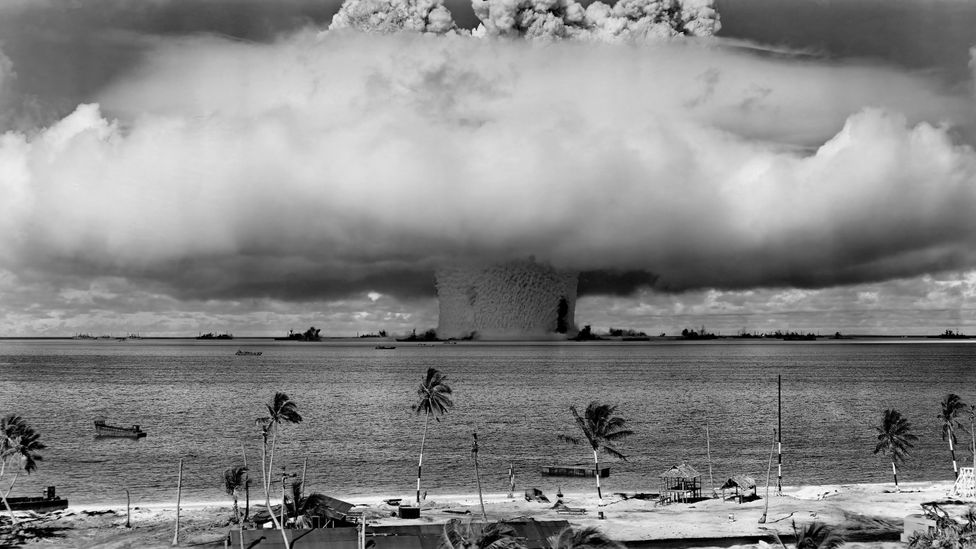
Nuclear tests at the Bikini Atoll contaminated a wide area with radiation, though the fish are now considered safe to eat (Credit: Getty Images)
A balancing act
However, Palumbi is keen to stress that a world without fishing would also have major drawbacks – particularly for those people who currently rely on the oceans for their income, staple diet or as a source of protein. "If we were only talking about oceanic mechanised industrial fishing fleets, that's one thing. But we also have to really remember that there's hundreds of millions of people at least that rely on very small-scale subsistence fisheries," he says. "Fishing plays a pretty important role for a lot of people's lives."
One possible way out is aquaculture, which already produces more than half of the total seafood consumed today. The approach comes with many challenges – from infesting wild salmon with sea lice to the difficulty of checking up on the welfare of underwater farm animals – but many organisations, including the UN, have suggested that it could help to make our exploitation of the oceans more sustainable. (Read more from BBC Future about the most environmentally friendly seafood.)
Alternatively, just switching to more sustainable practices alone could have a staggering impact on the productivity of the oceans – with benefits for both people and wildlife. If they were adopted globally, catches could increase by 16 million tonnes – enough to feed 75 million more people – according to an estimate by the Marine Stewardship Council.
There is more good news. Unlike many of the animals our species has overexploited on land, fish have an astonishing capacity to recover. While a cheetah can only have a handful of babies at one time – with three months of pregnancy and about 18 months per litter to train them to survive – an equivalent apex predator in the oceans, such as a tuna, can produce up to 30 million eggs at a time. "Now a lot of those little eggs don't survive, of course, but the potential for a population to rebound generation by generation [is huge]," says Palumbi.
For the moment, the idea that humanity would vacate the planet's oceans is as unlikely as it is contentious. But if larger swathes of the world's oceans were allowed to return to their former abundance – as with the Bikini Atoll and Marine National Monument in Hawaii – for many marine organisms, the last century could soon just be a small hiccup in the long, thriving history of their species.
--
Join one million Future fans by liking us on Facebook, or follow us on Twitter or Instagram.
If you liked this story, sign up for the weekly bbc.com features newsletter, called "The Essential List" – a handpicked selection of stories from BBC Future, Culture, Worklife, Travel and Reel delivered to your inbox every Friday.
